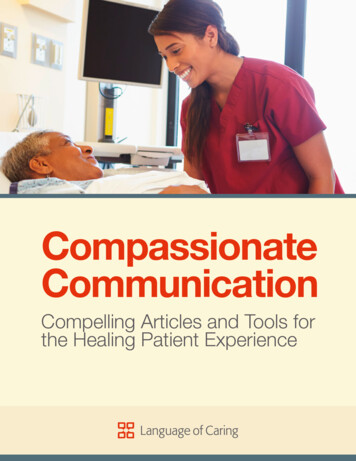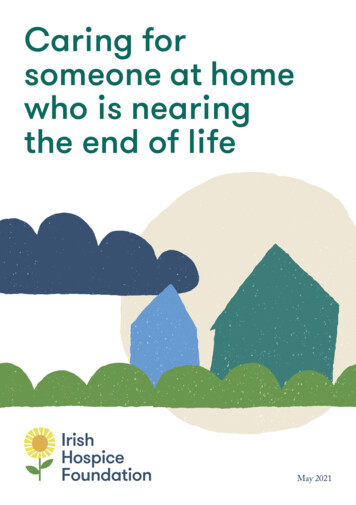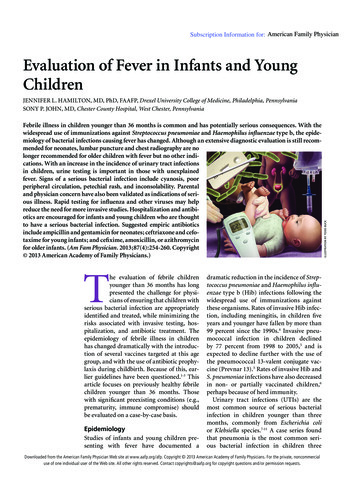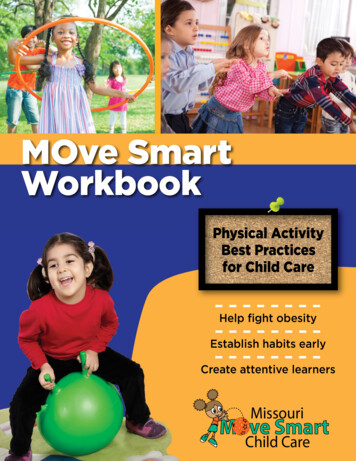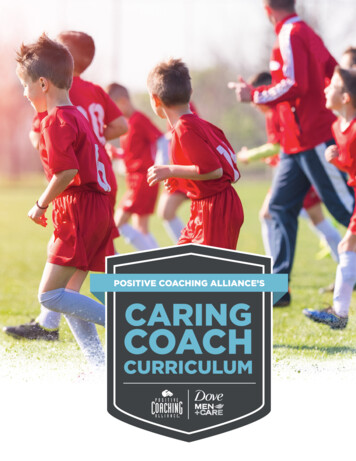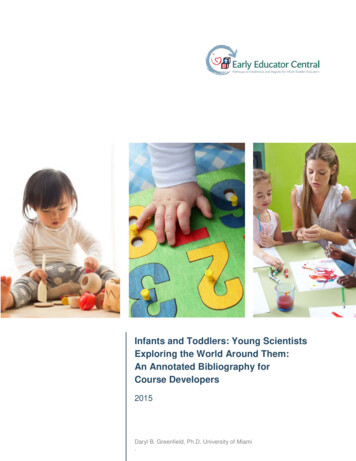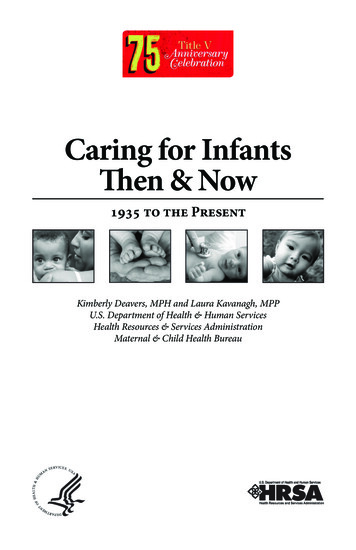
Transcription
Caring for InfantsThen & Now1935 to the PresentKimberly Deavers, MPH and Laura Kavanagh, MPPU.S. Department of Health & Human ServicesHealth Resources & Services AdministrationMaternal & Child Health Bureau
Produced by the U.S. Department of Health and Human Services,Health Resources and Services Administration,Maternal and Child Health Bureau in 2010in recognition of the 75th anniversary of Title Vof the Social Security Act.Bright Futures was produced by the American Academy of Pediatrics under itscooperative agreement (U06MC0002) with the U.S. Department of Health and HumanServices, Health Resources and Services Administration (HRSA), Maternal andChild Health Bureau.
Table of ContentsPreface . . . . . . . . . . . . . . . . . . . . . . . . . . . . . . . . . . . . . . . . . . . . . . . . . . . . . . . . 4Bath Time . . . . . . . . . . . . . . . . . . . . . . . . . . . . . . . . . . . . . . . . . . . . . . . . . . . . . . 5Infant Sleep. . . . . . . . . . . . . . . . . . . . . . . . . . . . . . . . . . . . . . . . . . . . . . . . . . . . . 6Medical Supervision . . . . . . . . . . . . . . . . . . . . . . . . . . . . . . . . . . . . . . . . . . . . . . 7Infant Immunizations. . . . . . . . . . . . . . . . . . . . . . . . . . . . . . . . . . . . . . . . . . . . . . 9Preventing Illness . . . . . . . . . . . . . . . . . . . . . . . . . . . . . . . . . . . . . . . . . . . . . . . 10Injury Prevention. . . . . . . . . . . . . . . . . . . . . . . . . . . . . . . . . . . . . . . . . . . . . . . . 11Breastfeeding . . . . . . . . . . . . . . . . . . . . . . . . . . . . . . . . . . . . . . . . . . . . . . . . . . 12Breast Milk Alternatives. . . . . . . . . . . . . . . . . . . . . . . . . . . . . . . . . . . . . . . . . . . 13Introduction to Solid Foods. . . . . . . . . . . . . . . . . . . . . . . . . . . . . . . . . . . . . . . . 15Oral Health . . . . . . . . . . . . . . . . . . . . . . . . . . . . . . . . . . . . . . . . . . . . . . . . . . . . 17Sun Exposure . . . . . . . . . . . . . . . . . . . . . . . . . . . . . . . . . . . . . . . . . . . . . . . . . . 18Physical Activity. . . . . . . . . . . . . . . . . . . . . . . . . . . . . . . . . . . . . . . . . . . . . . . . . 19Traveling with Baby. . . . . . . . . . . . . . . . . . . . . . . . . . . . . . . . . . . . . . . . . . . . . . 21Role of Fathers . . . . . . . . . . . . . . . . . . . . . . . . . . . . . . . . . . . . . . . . . . . . . . . . . 22
PrefaceTo celebrate the 75th Anniversaryof Title V of the Social Security Act, theHealth Resources and Services Administration’s Maternal and Child HealthBureau (MCHB) developed Caring forInfants: Then and Now to highlight theBureau’s longstanding commitment tohigh quality information for parents. Thispublication provides snapshots of infantcare recommendations selected fromInfant Care1, published by the FederalChildren’s Bureau in 1935, and BrightFutures: Guidelines for Health Supervision of Infants, Children, and Adolescents2, published by the American Academyof Pediatrics in 2008 under a cooperative agreement with the MCHB.Infant Care was first published by the Children’s Bureau in 1914 in responseto high rates of infant death found throughout the country3. The pamphlet provided mothers with up-to-date information, with the goal of improving babies’ healthand preventing infant deaths. At the time, many women learned how to care fortheir children through motherly and peer advice, cultural traditions, and trial anderror, rather than written resources. Infant Care was the first government publication of its kind, and it became a Children’s Bureau “bestseller.” In 1935, the yearTitle V of the Social Security was enacted, over 8 million families received a copyof Infant Care4. By the final 1989 edition, several hundred million copies hadbeen distributed.While some messages have remained consistent over time, others havechanged, reflecting the evolution of both scientific knowledge and attitudes aboutthe roles of parents vis-à-vis professional “experts.” Since the first edition of Infant Care to the current Bright Futures, the Federal government has continued tosupport parents, families, and caregivers with up-to-date information about theirinfants’ health and development.References1 United States Department of Labor. Infant Care, Children’s Bureau Publication No. 8,Washington, DC: U. S. Government Printing Office; 1935.2 Hagan JF, Shaw JS, Duncan PM, eds. Bright Futures: Guidelines for Health Supervision of Infants, Children and Adolescents, Third Edition. Elk Grove Village, IL: AmericanAcademy of Pediatrics; 2008.3 Reed J. Infant care - then and now. Children Today. 1981; Jan/Feb: 16-20.4 U.S. Department of Health, Education, and Welfare. The Story of Infant Care. Washington, DC: U. S. Government Printing Office; 1965.
Bath TimeIn 1935 Infant Care advised.A healthy baby should be bathed everyday. During the first two weeks thisand all the matters pertaining to the care of the baby usually are under the supervision of the doctor or nurse. The full tub bath may be given as soon as the scarwhere the navel cord was attached has fully healed. For some weeks a tiny babymay be bathed in a basin or bowl; after that he should have a tub bath.The mother may find it more convenient to give the bath before the mid-morning feeding, after the bowels have moved. Never bathe a baby within an hourafter feeding. Sometimes it may be more convenient to give the bath at night, justbefore the baby’s bedtime. The water should be slightly above body heat; that isabout 105 F. A bath thermometer that floats is useful, but if none can be had themother may test the temperature with her elbow. When the water is neither hotnor cold it will be comfortable for the baby. Never add hot water to the bath whilethe baby is in the tub. Never put the baby into the bath while the tub is standingon a stove or heater; he might be seriously burned in this way. Never bathe ababy close to the kitchen stove. Never leave a young baby alone in the tub.Bright Futures now recommends.Your baby’s skin may not need to be washed with soap daily. However,“cradle cap” can be prevented with frequent washing of the scalp.To protect your baby from tap-water scalds, the hottest temperature at thefaucet should be no higher than 120 F. Before bathing the baby, always test thewater temperature with your wrist to make sure it is not too hot.Never leave your baby alone in a tub of water. A bath seat or bath ring is not asafety device and is not a substitute for adult supervision.A newborn baby’s skin is sensitive. Using fragrance-free soaps and lotionsfor bathing, and fragrance-free detergents for washing clothes will reduce thelikelihood of rashes. In addition, oils and heavy lotions tend to clog pores andincrease the likelihood of rashes. For areas of dry skin, such as creases and feet,moisturizing lotions are recommended. Powders are not recommended becauseof the possibility of inhalation and possible respiratory problems.
Infant SleepIn 1935 Infant Care advised.A very young baby should sleep from 20 to 22 hours out of the 24; during thesecond and third months about 18 to 20 hours. It should be remembered that babies vary in their needs for sleep. Some require less than these amounts; somerequire more. The baby should be trained from birth to have his longest unbrokensleep at night. He should always sleep in a bed by himself, and whenever possible in a room by himself, where he need not be disturbed by the presence ofother persons and where light and ventilation may be adjusted to his particularneeds.A baby should never be put to sleep in all of his clothes. Before going to bedat night he should be sponged off with a wash cloth wrung out of lukewarm water.He will sleep better both day and night if he is comfortable. Never allow a baby togo to sleep with anything in his mouth. He should not be allowed to suck a pacifier, nor his fingers, nor even his bottle.Bright Futures now recommends.At this age, newborns usually lack a day/night schedule and sleep for a longerstretch during the day. Your baby will need help from you and other caregivers todevelop sleep and feeding routines. Putting your baby down to sleep in the sameplace every time and establishing a regular routine for feeding and sleeping willhelp him get on a schedule and will help him sleep at night.To reduce the risk of SIDS, it is best to always have your baby sleep on herback, not on her tummy or side.Do not use loose, soft bedding (blankets, comforters, sheepskins, quilts, pillows, pillow-like bumper pads) or soft toys in the baby’s crib, because they areassociated with an increased risk of SIDS. Thin blankets can be used to swaddlethe baby, or in a crib if the blankets are tucked in under the crib mattress.It is also a good idea if your baby sleeps in your room in her own crib (not inyour bed). If you breastfeed or bottle-feed your baby in your bed, return her toher own crib or bassinet when you both are ready to go back to sleep.Remember to choose a crib with slats that are no more than 2 3/8 inches (60mm) apart and with a mattress the same size as the crib. A crib should be certified by the Juvenile Products Manufacturers Association.Using a pacifier during sleep is strongly associated with a reduced risk ofSudden Infant Death Syndrome (SIDS).
Medical SupervisionIn 1935 Infant Care advised.To keep a baby well there should be continued supervision by a doctor trainedin the care of babies. The mother can not know nor recognize many of the earlysigns of trouble because she is not trained to do this and because she is too nearthe baby and sees him too often to realize that any change is taking place. Thedoctor, who sees the baby once or twice a month, looks at him with a trainedeye and can see whether he isas rosy as usual or is becominga little pale, whether he is as active as he should be, or whetherhe shows other early signs thatare the forerunners of trouble. Amother can not know just whenher particular baby needs to havehis food changed or increased,nor when is the best time forher baby to be protected fromdiphtheria and vaccinated againstsmall pox. Such things as thesethe doctor will know, and his advice is of the greatest importanceto every mother who would keepher baby well. The doctor’s supervision of a baby should begin as soon as thebaby is born.Regular visits to the doctor should be made for three purposes: (1) Weighing(weekly); (2) advice (monthly); (3) health examinations (every four months). Themother and baby should be seen by the doctor whether at his office or at a wellbaby conference, at least once a month, and oftener if the baby is not doing wellor if he is artificially fed so that the baby’s diet may be discussed as well as hishabits of eating, sleeping, exercise, outdoor life, and elimination.Bright Futures now recommends.The first priority of every health supervision visit is to attend to the concernsof the family. Many parents are aware of developmental delays or irregularitiesbefore they are told them by a health care professional. Their concerns must bepromptly responded to, and an appropriate evaluation must be initiated.The number of newborn health supervision visits will depend on the mode ofdelivery and the presence of maternal and neonatal complications.
Bright Futures Guidelinesrecommends at least a prenatal visit,newborn visit, first week visit, andfollow-up visits at the first, second,fourth, sixth, and ninth month of lifeduring the infancy period.
Infant ImmunizationsIn 1935 Infant Care advised The large majority of babies are well when they are born. The universalproblem is how to keep them well. Many diseases of babyhood are much lesscommon today than they used to be because modern science has found out howthey can be prevented. Some diseases can be prevented by feeding the babyproperly and by giving him plenty of sunlight and some by vaccinating or inoculating him with a protective substance.Every baby should be vaccinated against smallpox before he is 12 monthsold. This should be done whether there is any smallpox in the community or not,as the disease may break out when least expected.Every baby should be immunized against diphtheria when he is six monthsold or as soon as is possible. This is done by the injection of three doses oftoxoid or toxin-antitoxin. Six months later the baby should be given the “Schicktest” to see whether the treatment has protected him against the disease. In themajority of babies thus treated the test shows that the baby has been protected,but in a few the test will show that they need to have the injections repeated. Besure to have the Schick test done and find out whether your baby is safe.Bright Futures now recommends The value of immunizations in avoiding preventable diseases and diseasecomplications is an important discussion for providers to have with parents.For the immunization schedule, Bright Futures uses the most currentrecommendations of the CDC National Immunization Program(http://www.cdc.gov/vaccines) and the American Academy of PediatricsRed Book (http://www.aapredbook.org). In 2010, these sources recommendedimmunizations in the first year of life to protect against hepatitis B, tetanus,diphtheria, pertussis, polio, Haemophilus influenzae type b, pneumococccus,and rotavirus.
Preventing IllnessIn 1935 Infant Care advised.Prevention of ColdsBabies are very susceptible to common colds and are frequently made veryill by what is “just a cold” in adults. All persons having colds or coughs should bekept away from the baby. No one should lean or talk over a baby, or breath in hisface, since breath carries a fine spray which may be loaded with germs. Somepersons though they apparently have no colds themselves, are carrying germs intheir noses or throats which will produce disease in a baby.Avoid overheating of the rooms in which a baby lives. Keep the air fresh byleaving a window open a little way. Do not overheat the baby by wrapping himup too warmly when he goes out. If he perspires too freely outdoors he may bechilled when he comes indoors and has his wraps removed. Never take a babyinto a crowded place, for some one in the crowd may have a cold and the baby islikely to catch it. Do not let the baby get too tired.Bright Futures now recommends.One of the most important steps in keeping your baby healthy is to wash yourhands frequently with soap and water or a non-water antiseptic, always afterdiaper changes and before feeding your baby. You also should ask all familymembers and guests to wash their hands before handling the baby.Newborns are susceptible to illnesses in the first few months of life and needto be protected from anyone with colds or other illnesses. Outings to faith-basedactivities, restaurants, and movies should be considered carefully and avoidedduring cold and flu season.Avoid crowded places, overdressing, and exposure to very hot or coldtemperatures.As long as you wash your hands before breastfeeding, you can continue tobreastfeed through most illnesses that you or your baby have.Injury PreventionIn 1935 Infant Care advised.How to Prevent Accidents: BurnsBurns are far too common in infancy. They should be prevented by keepingthe baby away from the stove, open fires, and gas or electric heaters. Keep himin his crib or in a play pen, at a safe distance from any heater. Never bathe him
close to the stove, as tragic accidents have been caused by overturned kettles ofhot water.How to Prevent Accidents: PoisoningsKeep all bottles of medicines or boxes of pills on high shelves or in cupboardswell out of the baby’s reach. Do not leave the bottle of iodine on the washstandor table. Keep the kerosene can in a closed cupboard or other safe place. A babywho bites his painted crib or other piece of painted furniture may get lead poisoning; he should have an unpainted wooden crib or one painted with paint containing no lead.Never use a baby powder containing stearate of zinc unless ordered by yourdoctor. Never give a baby a can of baby powder as a plaything, even one that isapparently empty. If he puts the top in his mouth he may inhale the powder. Ifstearate of zinc is inhaled, a serious and often fatal form of pneumonia develops.Always keep such poisons as lye on high shelves out of the baby’s reach.Never leave a can of lye on the floor or in any place where a creeping child mightget hold of it. Lye causes a type of burn in the mouth and throat that may resultfatally. To avoid gas poisoning, be sure that gas fixtures do not leak and thatlights that might be blown out accidentally are not left burning.Bright Futures now recommends Promoting safety and preventing injuries is a continuing task for parentsduring the first year of their child’s life. Although suffocation and motor vehiclecrashes are the most common causes of unintentional injury and death duringthis age, the infant also is at risk of other injuries, including falls, fires and burns,poisoning, choking, and drowning. Each of these tragedies is preventable, andappropriate counseling can provide parents with the knowledge and strategies forreducing the likelihood that these injuries will occur. Always put your baby down to sleep on his back, not on his tummy or side. Always use a rear-facing car safety seat to transport your baby in all vehicles. It is very important for your baby’s health that your home, vehicle, and otherplaces the baby stays are smoke-free. Do not drink hot liquids while holding the baby. Always keep one hand on your baby when changing diapers or clothing on achanging table, couch or bed, especially as she begins to roll over. Falls arethe most common reason for emergency room visits for injury.
BreastfeedingIn 1935 Infant Care advised.The way the baby is fed during the first year of life may make him eitherstrong and healthy or weak and sickly; wrong feeding may even be the cause ofhis death. For this reason a physician experienced in the care and feeding of infants should be consulted as soonas the baby is born and at regularintervals thereafter; at least once amonth if the baby is breast fed andmore frequently if he is artificiallyfed. He will advise the mother withregard to all the details of feeding.For the sake of the baby’s healththe doctor’s advice should be followed with the greatest of care.Breast milk is easily assimilated, cheap, clean, and convenient. No other thing has a greaterinfluence on the development andhealth of the baby than breast feeding. Breast feeding gives a baby abetter chance for life and for steady and normal growth. The death rate of babiesnot breast fed is higher than the death rate of breast-fed babies.Bright Futures now recommends .Breastfeeding is recommended for infants during at least the first year of life,because of its benefits to infant nutrition, gastrointestinal function, host defense,neurodevelopment, and psychological well-being. Cultural factors may influencebreastfeeding initiation and success. Parents need practical support for breastfeeding, as well as culturally–appropriate information and guidance.Breastfeeding during the first 4 to 6 months of life provides ideal nutrition andsupports the best possible growth and development.You should feed your baby when she is hungry. A baby’s usual signs ofhunger include putting her hand to her mouth, sucking, rooting, pre-cry facialgrimaces, and fussing. Crying is a late sign of hunger. You can avoid crying byresponding to the baby’s more subtle cues.In the first days of life, your baby should be encouraged to breastfeed about 8to 12 times in 24 hours to help the mature breast milk come in.
Feed your baby until sheseems full. Signs of fullness areturning the head away from thenipple, closing the mouth, andrelaxed hands.Burp your baby at naturalbreaks (e.g., midway through or after a feeding) by gently rubbing orpatting her back while holding heragainst your shoulder and chest orsupporting her in a sitting positionon your lap.Because alcohol is passed into the breast milk, it is important for mothers toavoid alcohol for 2 to 3 hours before breastfeeding or during breastfeeding.If you do not know your HIV status, it is a good idea to get tested; if you areHIV positive, it is possible to prevent transmission of the virus to your baby.Healthy babies do not require extra water, as breast milk and formula (whenproperly prepared) are adequate to meet the newborn’s fluid needs.Breast Milk AlternativesIn 1935 Infant Care advised.Artificial FeedingEvery baby should be under the supervision of a doctor, and at no time is thismore necessary than when artificial feeding is begun. During the first six monthsof life there is no perfect substitute for breast feeding. Therefore no baby shouldbe taken off the breast during this time unless there is a good reason. After thebaby is 6 months old artificial feeding can be begun more safely, but it is best thata baby should be at least partly breast fed until he is 8 or 9 months old.The most important problems in connection with artificial feeding are: (1) Thechoice of good milk supply; (2) the planning of the milk mixture so that it may beadequate in quantity and quality; (3) preparation of the milk mixture so that it maybe safe and digestible. The problem of the milk supply may be met by buying agood grade of milk (certified or grade A) that has been pasteurized. Cow’s milkis most commonly used, but in some sections of the country goat’s milk is moreabundant and may be used satisfactorily. The doctor should decide upon theingredients of the feeding and upon the amounts to be used. It is the consensusof the opinion among child specialists to-day that any milk or milk mixture fed toa baby should be boiled to render it absolutely safe and at the same time moredigestible.
Wet Nurses & Breast-Milk AgenciesSome newborn babies, especially those prematurely born, and some babieswho are very delicate or who suffer from chronic digestive disturbances can notbe made to thrive on artificial food. If such babies can not be nursed by theirmothers it is wise to provide breast milk, either by engaging a wet nurse or bybuying breast milk from a hospital or a breast milk agency. In some large citiesthere are agencies where breast milk can be bought or wet nurses engaged. Insmall towns or in the country wet nurses or breast milk can be had by advertising or by inquiring at a maternity hospital in some near-by city. Sometimes breastmilk may be obtained from a friend or a relative. It is often more satisfactory tobuy breast milk than to employ a wet nurse in the home. If it is bought from anindividual, it is desirable that the woman should come to the baby’s home, so thatthere may be supervision of the expression of the milk. All breast milk obtainedfrom an agency or hospital or from a wet nurse or other individual should beboiled and kept on ice in sterile bottles.Bright Futures now recommends .For mothers who are unable to breastfeed their baby or who choose not tobreastfeed, iron-fortified formula is the recommended substitute for breast milkfor feeding the full-term infant during the first year of life. Cow’s milk, goat’s milk,soy beverages (not soy formula), and low-iron formulas should not be used during the first year. Reduced fat (2%), low fat (1%), fat-free (skim), and soy milk arenot recommended for infants during the first 2 years.Carefully read the instructions on the formula container. It will give you important information about how to prepare the formula and store it safely. Talk withyour health care professional if you have any questions about how to prepareformula or before switching to a different brand or kind of formula.Prepare 2 oz of infant formula every 2 to 3 hours at first, and then providemore if your baby still seems hungry. As your baby’s appetite increases overtime, you will need to prepare and offer larger quantities of formula.It is important to always hold your baby close when feeding, in a semi-uprightposition, so that you are able to sense her behavioral cues of hunger, being full,comfort, and distress. Hold your baby so you can look into her eyes during feeding.When you feed your baby with a bottle, do not prop the bottle in her mouth.Propping increases the risk that she may choke, get an ear infection, and develop early childhood caries. Holding your baby in your arms and holding the bottlefor her give you a wonderful opportunity for warm and loving interaction with her.Burp your baby at natural breaks (e.g., midway through or after a feeding) by
gently rubbing or patting her back while holding her against your shoulder andchest or supporting her in a sitting position on your lap.Because formula is expensive, you may be hesitant to throw away any thatis left in the bottle. For food safety reasons, if your baby has not taken all of theformula at one feeding and you plan to continue using it, you should put it back inthe refrigerator. Do not mix this formula with new formula. If the formula has beenheated and has been out of the refrigerator for 1 hour or more, discard it.Introduction to Solid FoodsIn 1935 Infant Care advised.Some of the foods that a baby needs during his first year of life, in addition tobreast milk, are as follows:Cod-liver oil, which is given chiefly because it supplies vitamin D, the factorthat prevents rickets.Egg yolk, which is given chiefly because it supplies iron.Cereals and bread, which are given because they supply starch, protein, andminerals. Dark wheat cereals and bread are especially valuable for minerals,vitamin B, and roughage.Stewed fruits, such as prunes and apples, which are given chiefly becausethey help to regulate the bowels. These fruits also supply iron and other mineralsand vitamins A and B and roughage.Potatoes, which are given because they supply starch, minerals,and vitamin B.Bright Future now recommends Complementary foods, commonly referred to as solids, includeany foods or beverages besideshuman milk or formula. The AAPCommittee on Nutrition statesthat complementary foods can beintroduced in infants’ diets between 4 and 6 months of age and when the infantis developmentally ready. The AAP recommends exclusive breastfeeding for a
minimum of 4 months, but preferably for 6 months. During the second 6 monthsof life, complementary foods are an addition to, not replacement for, breast milkor infant formula.Foods associated with lifelong sensitization (peanuts, tree nuts, fish, andshellfish) should not be introduced until after 1 year or even later.Your baby may be ready for solid foods when: The tongue thrust reflex (pushing food out of the mouth) fades. She can raise her tongue to move pureed food to the back of the mouth. As she sees a spoon approach, she opens her mouth in anticipation of thenext bite. She sits with arm support and has good head and neck control so she canindicate a desire for food by opening her mouth and leaning forward.Your baby can tell you she is full or doesn’t want food by leaning back andturning way.As you begin solids, it is import to feed your baby in a bouncy seat or highchair that is adjusted to make sure your baby’s head, trunk, and feet are supported so that you can look at each other.Introduce single-ingredient new foods, one at a time, and watch for adversereactions over several days or weeks.Oral HealthIn 1935 Infant Care advised The development of teeth begins at least six months before birth. It is probable that the proper foods in the diet of the prospective mother help to lay thefoundation for healthy teeth in the baby and that lack of proper food will depriveboth her own and the baby’s teeth of some part of their normal vigor. After thebaby is born, in order that the teeth may continue to develop normally, it is ofthe utmost importance that he himself receive the best diet possible, namely,his mother’s milk. During the period of breast feeding it is also important that themother should eat the proper foods and get plenty of direct sunlight.
Teething is a normal process which continues from about the age of 6 monthsto 2 ½ years. During the time when a tooth is actually coming through the gumthe baby may be irritable or fretful and may not eat well, but teething alone rarelyaccounts for illness or fever. If, during the period from 6 to 18 months when thefirst 12 teeth are coming through, the baby is feverish or sick, a doctor should beconsulted, and the illness should not be attributed to “teething” until all otherpossible causes such as colds, abscess in the ear, and other diseases have beenruled out by the doctor.The child’s gums should be firm, dense, and a clear light pink in color, andthey should hold the teeth firmly in place. Any sign of a gumboil should be regarded as a danger signal.Bright Future now recommends Sharing spoons and cleaning a dropped pacifier in your mouth may increasethe growth of bacteria in your baby’s mouth and increase the risk that he willdevelop dental decay when his teeth come in.To protect your child’s eventual dental health, it is important for you to maintain good dental health. Because you may be the source of caries-promotingbacteria for your baby, it is important you visit the dentist, reduce the amount ofsugary drinks in your diet, take meticulous care of your teeth through brushingandflossing, and use a fluoridated toothpaste and/or rinse.The use of fluoride supplements will depend on whether your baby is breastfed or formula fed, as well as the water source. The local health department maybe a resource for information about local community fluoride levels.To avoid developing a habit that will harm your baby’s teeth, do not put him tobed with a bottle containing juice, milk, or other sugary liquid. Always hold yourbaby for a bottle-feeding and do not prop the bottle in his mouth or allow him to“graze” (drink from the bottle at will during the day).If your baby is teething, he may drool, become fussy, or put thin
A healthy baby should be bathed everyday. During the first two weeks this and all the matters pertaining to the care of the baby usually are under the super-vision of the doctor or nurse. The full tub bath may be given as soon as the scar where the navel cord was attached has fully healed. For some weeks a tiny baby
